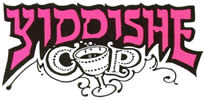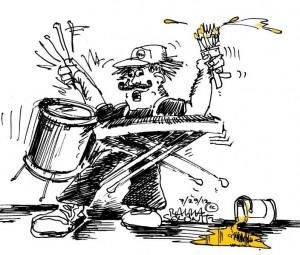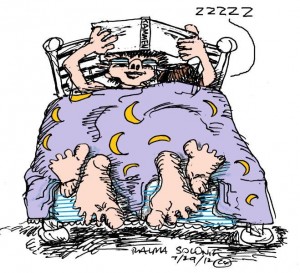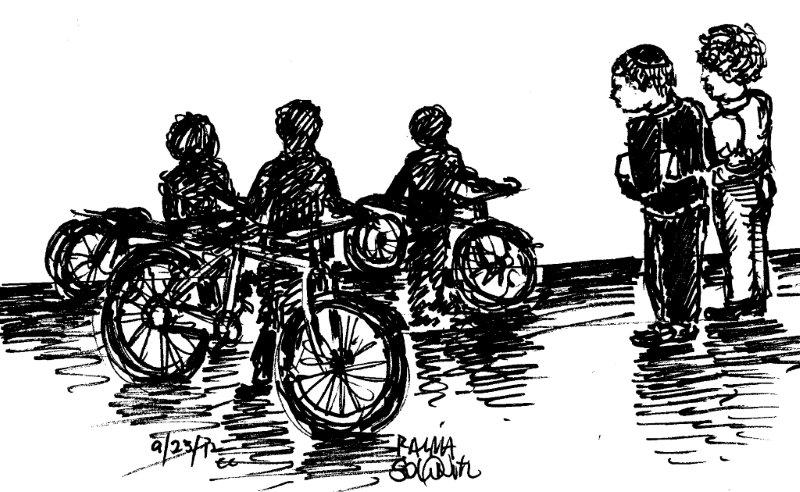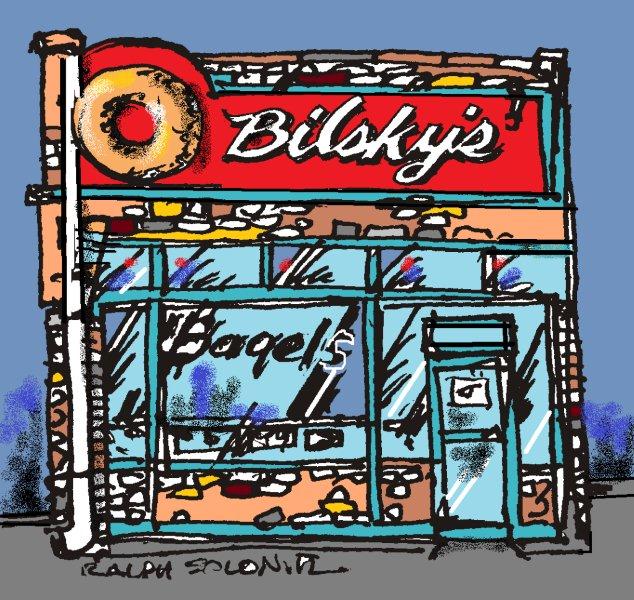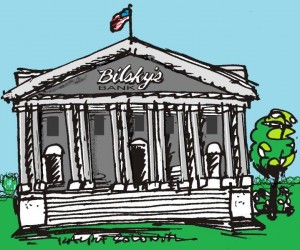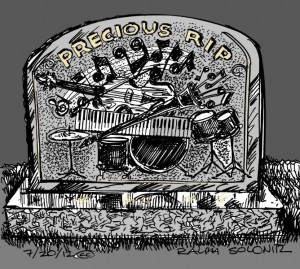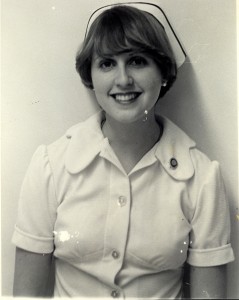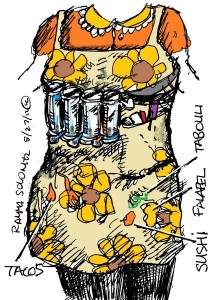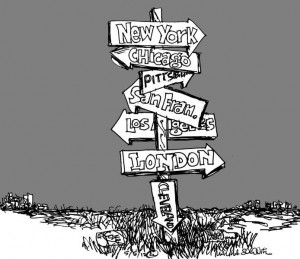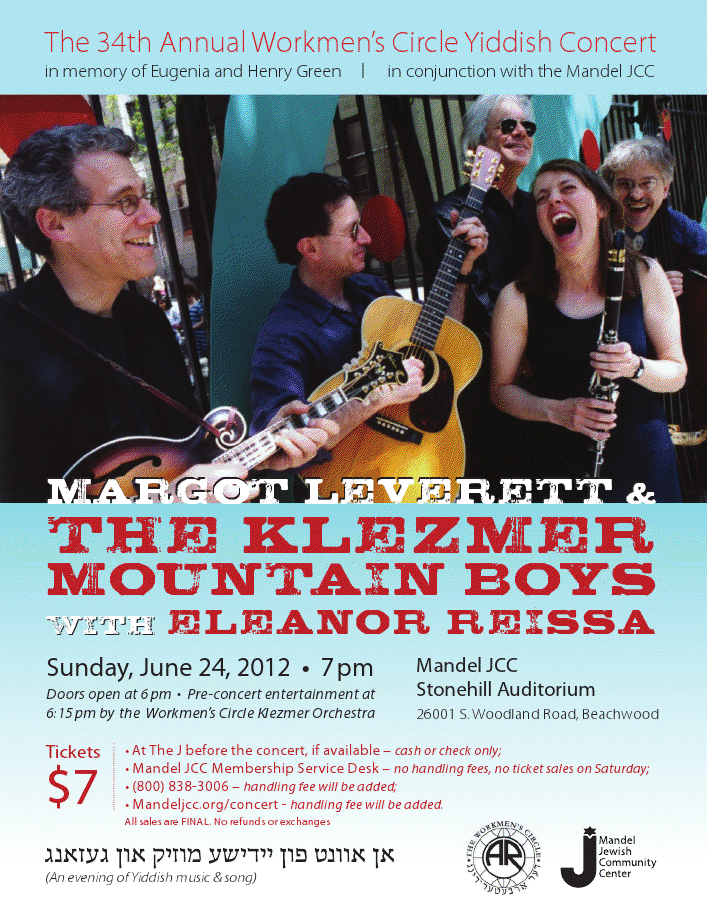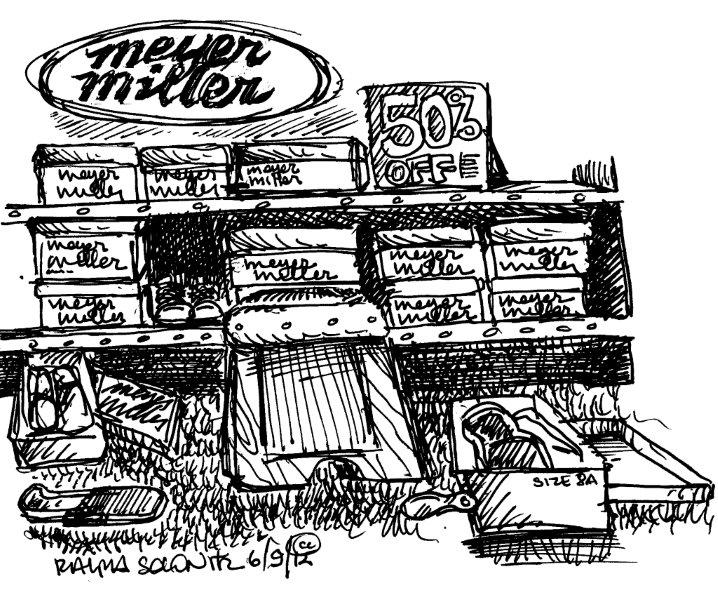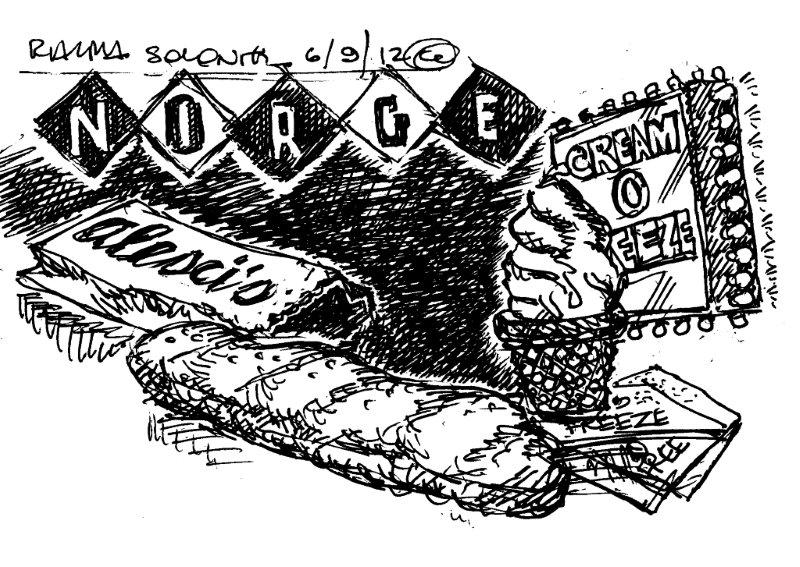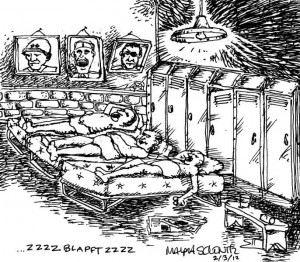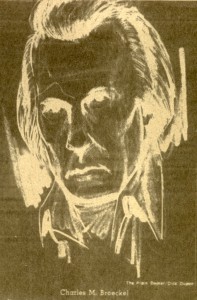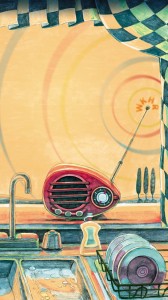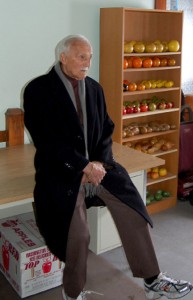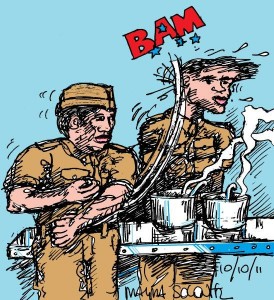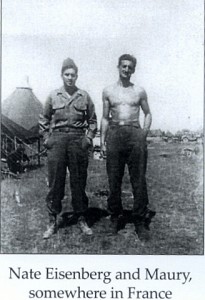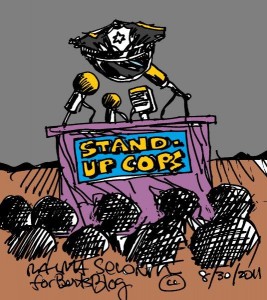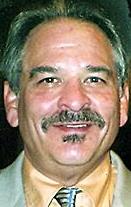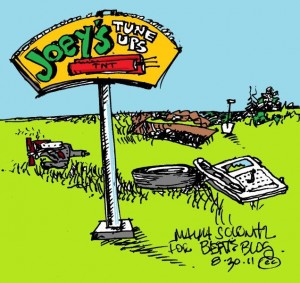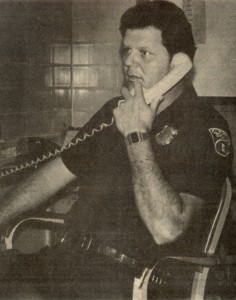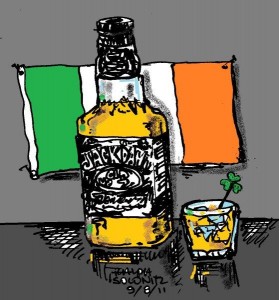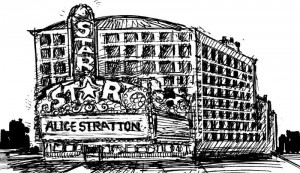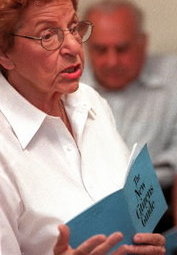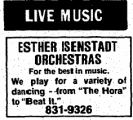Category — Cleveland, Full
SEIGER’S RESTAURANT
The cops at the Sixth District police station in Cleveland considered me a hippie spy from the Heights. But when I told the cops I was a Seiger (“My uncle owned Seiger’s Restaurant on E.118th and Kinsman”), the cops warmed up to me. The cops — the older ones, the bosses — all knew Seiger’s Restaurant.
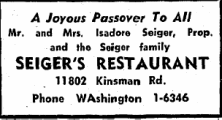
Cleveland Jewish News, 1968
Seiger’s Restaurant was a Damon Runyon casting hall on Kinsman Road. All manner of hustlers, cops, businessmen and shnorers (beggars) hung out there. The shnorers were Orthodox Jewish tzedakah (charity) collectors who had their own booth in the back.
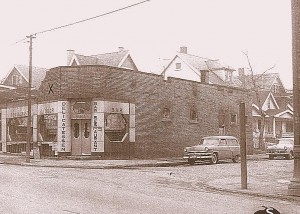
Seiger’s, 11802 Kinsman Rd., 1957
My Great Aunt Lil Seiger served the shnorers kosher food from her apartment, which was at the back of the store. The shnorers wouldn’t eat the non-kosher food from the restaurant. The deli was kosher-style, not kosher. “We served the rabonim [the rabbis] on special china and silverware, milchig [dairy]’,” Lil’s son Danny said.
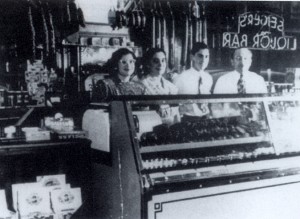
Seigers: Audrey (daughter), Lil, Danny (son) and Itchy, 1948
Rabonim — and cops — ate well at Seiger’s. Nobody ever got a ticket for an expired parking meter, and sometimes cars were parked two-lanes deep on Kinsman. “I couldn’t even spend a nickel in Seiger’s,” retired cop Bill Tofant said.
Itchy Seiger, my great uncle, was the owner and chief kibitzer (glad-handler/talker). He had been a cloak maker in Galicia, Austria-Hungary. Itchy was the greeter. Aunt Lil did the cooking, except the breads and strudels, which she bought.
There was a party room, seating about 65, in the basement. The matchbooks read: “Seiger’s Restaurant, Delicatessen, Barroom and Rathskeller.”
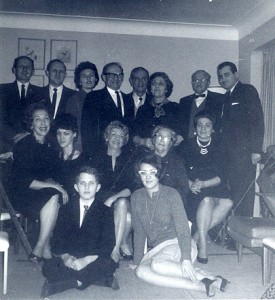
Danny and Itchy Seiger, back row, from R. Shiva for Anna Soltzberg, South Euclid, Ohio, 1964
I didn’t go to Seiger’s Restaurant often. My parents didn’t think Kinsman was the right direction for a Sunday drive. More often we wound up out east — the other direction — at the Metroparks.
Danny — my cousin — started showing up at Yiddishe Cup gigs in the 2000s. I asked him about the mini-feud between his father (my Uncle Itchy) and my grandmother, Anna Soltzberg (nee Seiger). Itchy and Anna had been half-siblings. (Enough with the genealogy, Klezmer Guy!) Danny said Itchy and Anna had had two things in common: sugar diabetes and iron wills.
My grandmother’s candy store — near Itchy’s deli on Kinsman — had frequently been “oyf tsoris” (badly off), and Itchy rescued it, Danny said.
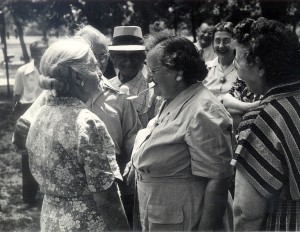
Anna Soltzberg, center, 1950s. Others unknown
“Everybody loved Itchy,” Danny said. Everybody but my grandmother, who complained about Itchy’s buy-out terms on her store. Later, my grandmother opened a candy store further east on Kinsman, near Shaker Heights.
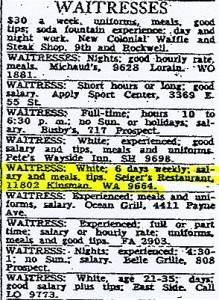
Cleveland Plain Dealer , 1947
“At the restaurant, there were two brothers, the Schoolers,” Danny said. “One, Joe, wanted a soft matzo ball. The other, Morty, wanted a matzo ball as hard as a baseball. Ma made both kinds. That’s how we thrived.”
Somebody should take Danny, age 80, and a video camera for a stroll down Kinsman. Walk Danny through the old neighborhood and into Seiger’s, which was recently a soul food restaurant. (Today it’s boarded up.)
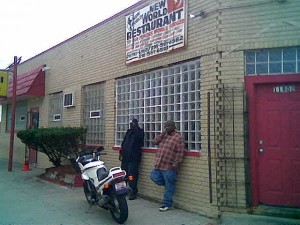
New World Restaurant, formerly Seiger’s, 2010.
The audio,
Danny: “This is where Ma made the mish-mash soup. She gave the recipe to Corky & Lenny’s. This is the counter where Jim Brown bounced a $10 check. I should have saved it for the autograph. This is where Oscar Schmaltz downed an industrial canister of soup. Oscar weighed 400.”
—
Footnote: Seiger’s is pronounced Sigh-ger’s (rhymes with High-gers) by Jews, and See-ger’s by cops. Seiger’s closed in 1968.
—
For relatives only . . . family photo above, taken at the shiva for Toby Stratton’s mother, Anna Soltzberg.
On floor, from L: Bert Stratton, sister Leslie.
Middle: Aunt Lil Soltzberg of Washington; Janice Bregman (wife of Marc Bregman); Aunt Pearl Bregman; Great Aunt Molly Mittman; Marcia Seiger.
Top: Uncle Milty Soltzberg, Toby Stratton, Julia Stratton, Uncle Sol Soltzberg, Great Uncle Sam Mittman, Aunt Lil Soltzberg of Delaware, Great Uncle Itchy Seiger, Danny Seiger.
(Sol Soltzberg, Milty Soltzberg, Pearl Bregman and Toby Stratton were siblings.) Marc Bregman — the son of Pearl Bregman — probably took this photo.
May 8, 2013 12 Comments
MISSISSIPPI BUBBE AND
THE XYLOPHONIST
I look for musical yikhes (lineage/pedigree) wherever I can find it. My grandmother played piano at a white Baptist church in Yazoo City, Mississippi. Not bad.
This Mississippi bubbe — Ida Kassoff Zalk — had a brother, Earl Kassoff, in Cleveland. Earl was a drummer, xylophonist and house painter. He went by the stage name Earl Castle, and led bands in the 1930s and 1940s.
In the 1990s — when I first began looking for musical yikhes — I couldn’t find much info on Earl. I talked to a couple relatives. Earl didn’t leave behind sheet music or tune books. He died in 1969.
At a Yiddishe Cup gig, an elderly musician schmoozed with me. I asked him if he knew Earl Kassoff. Yes, he remembered Earl. The schmoozer was Harold Finger, age 77. He had made a living playing clarinet and sax during the 1930s and 1940s.
I took my tape recorder to Harold’s apartment and interviewed him. He said there were “four or five bands that got the Jewish work.”
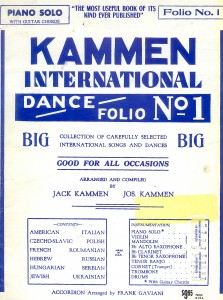 I asked, “What bands?” He didn’t remember the names. “What were the most popular Jewish tunes?” I said.
I asked, “What bands?” He didn’t remember the names. “What were the most popular Jewish tunes?” I said.
He said, “The songs from the Kammen Book. That was the big thing.”
The Kammen International Dance Folio, published in 1924, is still around. The Kammen book is to Jewish music what a sex manual is to sex. (Pianist Pete Sokolow makes this statement at most KlezKamp conventions.)
My Uncle Earl’s band did mostly “dance work” — American music, Harold said. Earl worked the downtown theaters, as well as the Golden Pheasant — a Chinese restaurant where Artie Shaw started.
Harold said he didn’t stick to the melody all the time. He did some “faking” (improvising). Now he played clarinet with a community orchestra. “I don’t do much jobbing anymore,” he said. (Jobbing is gigging.)
Harold died three years after the interview. I thought his kids might enjoy the interview tape, from 1992, so I called a Finger relative and left a message in the mid-1990s.
I didn’t hear back.
The relative should have called! Harold’s wife was on the tape, teasing Harold about how he loved his saxophone more than her. Harold said, “What? I quit playing music for you!”
—
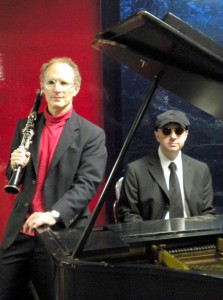 Michiganders, come to the Klezmer Guy show at The Ark, Ann Arbor, Feb. 15. 8 p.m. $20. Bert Stratton on clarinet and prose, Alan Douglass on piano and vocals, Gerald Ross on ukulele and Hawaiian lap steel guitar. Prose pieces will contain words such as “Ann Arbor,” “Michigan” and “Rudy Tomjanovich.”
Michiganders, come to the Klezmer Guy show at The Ark, Ann Arbor, Feb. 15. 8 p.m. $20. Bert Stratton on clarinet and prose, Alan Douglass on piano and vocals, Gerald Ross on ukulele and Hawaiian lap steel guitar. Prose pieces will contain words such as “Ann Arbor,” “Michigan” and “Rudy Tomjanovich.”
—
More on Mississippi Ida — my bubbe — later. Maybe not.
—
Yikhes update. Check out the latest from Jack Stratton’s band, Vulfpeck.
February 6, 2013 6 Comments
AFRO-SEMITIC ENCOUNTER
I’m not Orthodox, but I can walk the walk. Walking is a major part of my religion.
Last week my wife, Alice, and I walked home from Rosh Hashanah services. We were at Altamont and Compton roads, in a mostly black section of Cleveland Heights — close to a mostly Orthodox neighborhood.
Three black boys pulled up on bikes. The boys were out of school because Cleveland Heights closes on Rosh Hashanah.
I had on a yarmulke. I like to wear a yarmulke in public once in a while, just to “out” myself.
D’Shawn, leaning on his handlebars, said, “You Jewish?”
“Yes,” I said.
He turned to Alice. “You Jewish?”
“Yes.”
“Total Jewish?” he asked.
“Yes,” my wife said, smiling. She knew D’Shawn. Alice teaches gym in the local public school and knows a lot of kids. “Being Jewish is a good thing. The food is good . . .”
“You go to that building [synagogue] up on Taylor?” D’Shawn asked.
“No, we go to the big temple — the one with the dome — over there,” Alice said, pointing toward Euclid Heights Boulevard.
Alice wears slacks. She doesn’t wear a wig. She doesn’t look Orthodox. (She isn’t — not by a long shot.)
“You breaking Armish?” D’Shawn said.
I said, “Breaking Armish? Did you say ‘breaking Armish’? What’s that mean? You mean ‘breaking Amish’?” Either way, it made no sense to me.
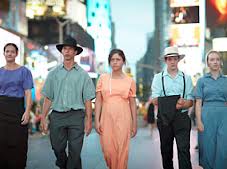
"Breaking Amish"
Breaking Amish is a reality TV show about Amish kids breaking loose in New York. The first episode was on last week. (I Googled this info when I got home.)
D’Shawn apparently thought Alice was “breaking Armish” because she doesn’t look like a member of the local black-hat Orthodox crowd.
—
Side B — “Beer and Coconut Bars,” a classic blog post — is below this video.
This clip may be the most innovative vid on earth. By Jack Stratton. Michael Brecker (on electronic wind instrument) jams with Uncle Milty Friedman.
—
SIDE B
A version of this post ran on CoolCleveland.com last year (12/6/11). This version has more illustrations and pics!
BEER AND COCONUT BARS
My dad admired bankers. In my dad’s pantheon of great Cleveland Jewish families, the number one clan was the Bilsky family, who made bagels, then went into medicine (son #1), bowling alleys (son #2), and started a bank (son #3). My grandmother used to say “The Bilskys make big bagels out of little bagels.”
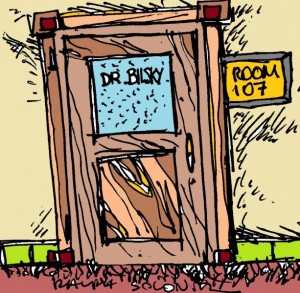 Scott Bilsky, 37, called to book Yiddishe Cup for a Fairmount Temple event. He said 12 Bilskys would be at the temple party.
Scott Bilsky, 37, called to book Yiddishe Cup for a Fairmount Temple event. He said 12 Bilskys would be at the temple party.
Dr. Harold Bilsky, son #1, had liked Yiddishe Cup. Harold had grown up with my dad on Kinsman Road. Harold wouldn’t be at the gig. He died in 2007. Leo, son #2, wouldn’t be there either. He died in 1998. I asked Scott, “What about the banker?”
“That’s my grandfather Marvin,” Scott said. “He’ll be there.” Marvin is 90.
At the gig, I talked to Marvin during our breaks. He told me, “Everything I ever did began with a B — baker, banker and builder. Plus brewer.”
That “brewer” part was news to me — Bilsky a brewski?
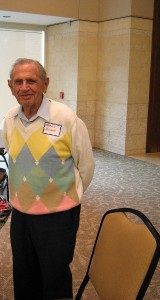
Marvin Bilsky, 2011
“My father bought Cleveland-Sandusky Brewing in 1955,” Marvin said. “There were very few Jews involved in the brewing business then. In the 1960s, Israel came to us for brewing tips and equipment.”
Marvin said there were only four other Cleveland breweries in the 1950s: Carling’s from Canada (“very nice people”); Standard Brewing; Erin Brew, Irish; Leisy’s, German; and Pilsener’s P.O.C., Czech. Bilsky’s brewery bottled Gold Bond beer and Olde Timers Ale.
“We all used to meet on Mondays. I didn’t have any trouble with anybody,” Marvin said.
The last local brewery in town was Carling, which closed in 1984. National breweries killed off the locals.
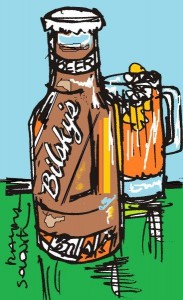 My father never taught me about brewskis. He rarely drank; it would have interfered with his worrying. (Old Jewish joke.) I knew about Carling’s from old Cleveland Indians’ radio ads. “Hey, Mabel, Black Label . . . Carling Black Label beer.”
My father never taught me about brewskis. He rarely drank; it would have interfered with his worrying. (Old Jewish joke.) I knew about Carling’s from old Cleveland Indians’ radio ads. “Hey, Mabel, Black Label . . . Carling Black Label beer.”
Bilsky’s brewery was just a blip in the Bilsky biz history. The Bilsky business was Bilsky’s Bakery, which had started on Kinsman and moved to Cedar Center in 1948.
Who invented the Cleveland coconut bar?
That was the question I should have asked Marvin. My dad had loved coconut bars (and halvah). I should have asked.
 Marvin was in the phone book . . . .
Marvin was in the phone book . . . .
“Marvin, this is Bert Stratton from Yiddishe Cup, the klezmer band.”
“Thank you for the concert yesterday. You did as well as you could,” he said. “No, seriously, we enjoyed it! To answer your question, I’ve always said my father invited the coconut bar, but — and I have to tell you this — I went to Sydney, Australia, and I went down into the subway there. They have a small subway system. They had coconut bars down there! They didn’t call them coconut bars. [Australians call them lamingtons, says Google.] Where did they get them? Maybe from England. Australia used to be part of England.”
“Marvin, I have a friend, my age — his grandfather was Kritzer’s Bakery on Kinsman — my friend says his grandfather invented the coconut bar.”
“It was my father!” Marvin said, laughing. “Who knows.”
I called my cousin George Becker, whose father had owned Heights Baking on Coventry. George said his father didn’t invented the coconut bar.
Yippee, one less Coconut Bar King to contend with.
Former Clevelander Scott Raab wrote in Esquire (July 2002): “Ask for coconut bars in any Jewish bakery from New Jersey to Los Angeles and you’ll get some version of this: ‘So, you’re from Cleveland . . . We don’t have ’em.’”
September 27, 2012 10 Comments
A LOVE SUPREME
The Jazz Temple was a music club in a former Packard showroom at Mayfield Road and Euclid Avenue. Coltrane played there. Dinah Washington too. 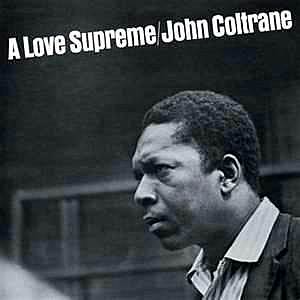 Everybody played there. The Jazz Temple was in business from 1960 to 1963.
Everybody played there. The Jazz Temple was in business from 1960 to 1963.
I passed the Jazz Temple weekly on my way to Sunday school at The Temple, a Reform synagogue in University Circle, Cleveland.
Rabbi Abba Hillel Silver was the head rabbi at The Temple. Rabbi Silver was very prominent; he spoke at the United Nations, advocating for the establishment of the state of Israel. Rabbi Silver’s son, Danny, was the assistant rabbi. He played football at Harvard and blocked hard for his dad.
The Sunday school kids at The Temple were mostly from Shaker Heights. One kid got a ride in a limo to shul. The driver wore a chauffeur’s cap.
I couldn’t grasp how temple — the word — fit into a non-Jewish setting, like in “Jazz Temple.” Was Jazz a religion too? (Give me a break. I was 10.)
Years later, I met a couple ex-beatniks who had been old enough to go to the Jazz Temple in the early 1960s. They had heard Trane and Ella.
The Jazz Temple was blown up in 1963. Somebody didn’t like the club, or the owner, Winston Willis, a controversial black businessman.
At The Temple, the religious-school kids would attend the last part of the service and hear the sermon. Rabbi Silver looked like God and talked like Him.
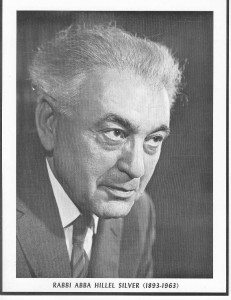 Today, at The Temple East in Beachwood, there is an Abba Hillel Silver memorial study. The rabbi’s desk is laid out like he just stepped out for lunch. He died in 1963.
Today, at The Temple East in Beachwood, there is an Abba Hillel Silver memorial study. The rabbi’s desk is laid out like he just stepped out for lunch. He died in 1963.
Rabbi Silver: Live at the Jazz Temple. Interesting.
John Coltrane: Live at The Temple. Another possibility.
A love supreme . . .
A love supreme . . .
—
SIDE B
PRECIOUS
In the arts, if you’re precious, you’re bad. Precious is the worst thing. Precious means you’re dainty and overly refined.
A friend (a former music critic) called all college a cappella music precious.
Harvey Pekar called Willio and Phillio — the Cleveland music-comedy duo — precious. (Willio and Phillio was around in the 1980s.) Willio and Phillio was precious — their stage name for sure. Willio (Will Ryan) went out to Los Angeles to work for Disney, and Phillio (Phil Baron) became a cantor in L.A. They were good, and probably still are.
Yiddishe Cup is precious occasionally. The musicians say “oy vey” too much on stage. I’ve tried to get my guys to stop. I can’t.
Peter Laughner, a Cleveland rocker, died from drug abuse and alcoholism at 24. He killed himself, basically. (This was in 1977.) He was not precious. He was dead — and funny — about art. He was in the Pere Ubu underground before Pere Ubu was famous.
Suicide doesn’t appeal to me for two reasons: 1) My wife would kill me if I tried it. 2) I want to attend my kids’ weddings and eventually meet my grandkids-to-be.
“Precious” is OK for grandkids. (“Grandkids” is precious.)
—
SIDE C
New construction — Side C — for Michiganders. . .
THE LODGE
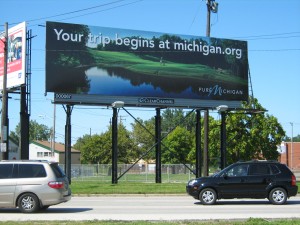
Chester Ave., Cleveland, 2011
I drove to Rochester, Michigan, which is not as cool as Rochester, New York, but it does have a small-town charm.
I’ve seen Father Coughlin’s former church in Royal Oak, Michigan.
I’ve been to Detroit many times.
My wife, Alice, said, “Detroit has very long roads.”
She probably meant Woodward, Gratiot and Telegraph.
Detroit also has the Lodge. Elmore Leonard mentions the Lodge in his books, like, “The gambling casino, Mutt, you can’t fucking miss it, over by the Lodge freeway.”
A couple Cleveland freeways and bridges have names, like the Bob Hope Memorial Bridge, but nobody ever uses the names.
I stayed at a hotel near the Silverdome, which looked like a big pillow. (The stadium did.) A Detroiter told me the Silverdome sold for about $200,000. A stadium for the price of a California carport.
Who was John C. Lodge? Probably a labor leader. [No, the mayor of Detroit in the 1920s.]
Detroit is like Cleveland. Detroit has the Eastern Market; Cleveland has the West Side Market. Detroit has downtown casinos. Now Cleveland has a downtown casino.
Metro Detroit has a few more Jews than Cleveland. And probably more Arabs, Poles and Ukrainians. And more blacks.
People who wear Tiger caps are cool, as are Indians cap wearers.
What about Berkley, Michigan? Is that worth a visit?
Elmore Leonard eats at the Beverly Hills Café. I wonder if that’s part of the Beverly Hills Café chain, or an independent restaurant in Beverly Hills, Michigan.
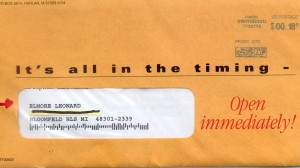 I wonder if Elmore Leonard spends his winters in Detroit. I bet he doesn’t. He writes a lot about Florida.
I wonder if Elmore Leonard spends his winters in Detroit. I bet he doesn’t. He writes a lot about Florida.
I have some Elmore Leonard junk mail.
City Primeval: High Noon in Detroit. That’s worth reading.
Maple means 15 Mile. Big Beaver is 16 Mile.
What about Oakland University? Does the university have Bobby Seale barbecue sauce in the cafeteria?
I live only three and a half hours from Berkley, Beverly Hills and Oakland.
—
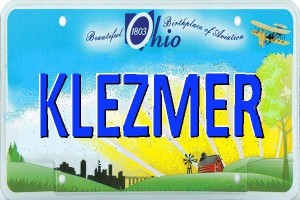 Yiddishe Cup pulls into Motown Sunday. See us at Cong. Beth Shalom, Oak Park, Mich.,
Yiddishe Cup pulls into Motown Sunday. See us at Cong. Beth Shalom, Oak Park, Mich.,
2 p.m., Sept. 9. Open to the public. Concert info here.
September 5, 2012 7 Comments
TICKTIN
Harold Ticktin, 85, writes a weekly column for the Cleveland Jewish News on Yiddish. For instance, he writes about what balabuste means, or balegole. (Female boss and wagon-driver.)
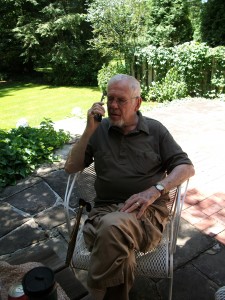
Harold Ticktin, Shaker Heights, 2012
Also, Harold occasionally reflects on early-20th century leftist politics for magazines such as Jewish Currents.
I asked Harold for a couple Yiddish translations. I was in his backyard in Shaker Heights. I wanted to know Yiddish permutations on “How’s it going in?” — everything from “How are you?” to “What’s happnin’, man?” Ticktin gave me some options, none perfect, and concluded, “Translation is treason.”
He continued, “Listen, there was this pharmacist who did a big business in trusses – you know what a truss is?”
“Yes.”
“The pharmacist’s slogan was Ayer kile iz undzer gedile — your hernia is our pleasure. I told the pharmacist that was a horrible translation. He told me to come up with a better one. I said, ‘Your rupture is our rapture.’ Wouldn’t that make a great bumper sticker for an abdominal surgeon?”
“Did you make that up — your rupture is our rapture?” I said.
“That’s a true story. It’s an absolutely true story.”
Ticktin is a retired workers’ comp lawyer. He can speak decent Italian, French and Spanish, as well as Yiddish. One of his favorites translations is All Screwed Up, he said, for the Lina Wertmuller film Tutto a posto e niente in ordine, which literally means “everything ready, nothing works.” “You don’t translate, you render,” Ticktin said.
Ticktin continued, “James Thurber ran into a woman in Germany who said, ‘I love your work in German.’ Thurber said, ‘Yes, it’s true, my work loses something in the original.’”
Ticktin lives three miles from his old stomping grounds — the Kinsman neighborhood. Harold grew up on E. 154th Street, Cleveland, hard by the Shaker Heights-Cleveland line. He said Shaker had been “hakodesh hakadashim [the Holy of Holies] — the other.” Shaker had been nearly unapproachable, like the inner sanctum at the Temple in Jerusalem. “I didn’t know anybody in Shaker. Maybe one person.”
Kinsman Road was Ticktin’s main artery. He said, “I walked [down Kinsman] from 154th to E. 140th to observe the class struggle. My father was a Yankee. He came over here when he was two. He liked baseball. What did he know about politics? He knew this: Roosevelt was great and Hitler was bad.”
At E. 146 Street, Harold met Peter “The Brain” Ostrovsky. “I was converted to communism by Ostrovsky on the train to the Philly Navy Yard in 1946. I was converted just west of Pittsburgh.”
The upshot: “I saw the God who was to fail, though I still have a warm spot for Marx, for his Lincoln correspondence,” Harold said. “I’m a member of the extreme center now.”
I wanted Ticktin to give me a tour of Kinsman — the proste, working-class Kinsman of his youth. “How about it?” I said. “Now?” Ticktin agreed. We got in my Lolly the Trolley — my Mercury Sable.
***
Stop 1. Woodhill Park at E.116th. Ticktin: “I remember when I was 10 years old [1937] at Woodhill. It was a tremendous swimming pool. Everybody got out of the water. Why? Because Frieda Katz, a geferlikher (dyed-in-the-wool) communist took a swim with a black kid. The place cleared out. This was Frieda Katz from Katz’s Deli at E. 147th and Kinsman.”

Formerly Seiger's
2. Seiger’s deli at 118th. “I knew Hymie Seiger best. He went off to yeshiva in junior high. He just left. I didn’t even know what a yeshiva was.”
3. E. 121. “This was where I attended my one Seder as a child. On that street. Very important.” Ticktin eventually became president of his shul.
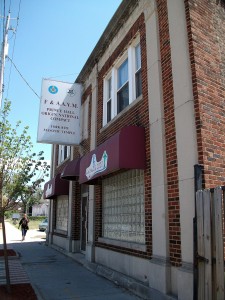
Council Educational Alliance building, now a Masonic hall
4. 13512 Kinsman, the Council Education Alliance. “The apex and GHQ [general headquarters] of my youth. The Communist Club met there.” It was a settlement house.
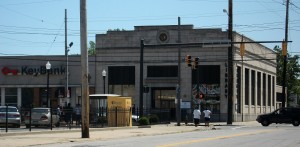
Cleveland Public Library - Mt. Pleasant branch
“In the 1936 election, the Communist Club painted ‘Vote Communist’ in blue on the library at E. 140th. The library had been a bank before. Some members of the club got mad because the graffiti was blue. They said, ‘We need to paint it red.’ Ostrovsky went back to re-paint it and got caught. He was defended by Yetta Land, who handled all the communists. I don’t think Ostrovsky was punished too severely; he was a juvenile.”
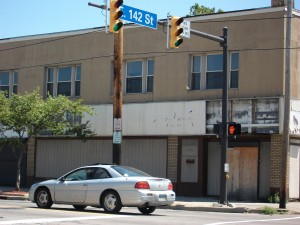
Formerly Spumoni's (middle store)
5. E 142 and Kinsman. “We called this place Spumoni’s. The real name was Giaimo’s — an ice cream place. The communists met across the street above the Woolworth’s, which is long gone.
“On Saturday nights all the single Jewish guys would hang out here at Spumoni’s and greet each other Marty-style, like, ‘Whadaya want to do, Marty?’ This went on up through the 1940s and 1950s.”
“What’s Marty-style.”
“Like Marty, the movie with Ernest Borgnine. You don’t remember it?”
“No.”
“Single Jews guys — and married Italians — hung out, to go out on the town. I always envisioned a cowering Italian wife in the kitchen back home saying, ‘Tony, when you gonna be home?’”
6. E. 154th / the Shaker Heights line. “Hakodesh — the other,” Ticktin said. “I was in New York once and stopped in at YIVO [Jewish Research Institute] for a list of places European Jews had vacationed before the war. I needed this for a speech in Yiddish. They asked me, ‘You mean intellectuals? Peasants? We’ll get back to you.’ They didn’t get back to me. A couple weeks later, I’m at a gathering of Jews and Poles in Cleveland, an American Jewish Committee meeting, and I meet the speaker, a prominent Polish Jew, Lucjan Dobroszycki, the editor of the Chronicle of the Lodz Ghetto. I ask him about vacation spots before the war. He looks at me and says, ‘This is the second time in two weeks somebody has asked me this question.’ End of the line, Lucjan Dobroszycki — don’t ask me how to spell that.”
7. I drive Harold Ticktin into Shaker Heights. Another end of the line.
—
The photos, above, are from 2012, except the former Seiger’s deli pic, which is from 2010. Seiger’s — later New World Restaurant — is now boarded up.
—
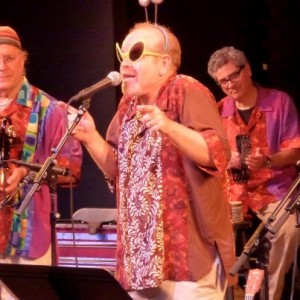 Yiddishe Cup plays a concert in Metro Detroit.
Yiddishe Cup plays a concert in Metro Detroit.
2 p.m. Sun. SEPT 9
Congregation Beth Shalom
Oak Park, Michigan
August 29, 2012 8 Comments
ALICE’S RESTAURANTS
Pre-kids, my wife, Alice, and I ate out a lot. We mostly went to dives. That was our hobby. Dives as low as Krisplee on East 82nd Street and Euclid Avenue, and Albino’s at West 44th Street and Lorain Avenue.
At home, Alice cooked a lot of tofu. That’s why we ate out a lot.
We don’t go out much now. I can’t stand the long waits, the so-s0 food, the noise. I’m my dad.
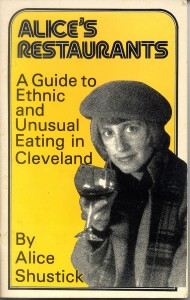 Alice published a restaurant guidebook, Alice’s Restaurants, in 1981. The book sold particularly well at the airport bookstore. Alice’s oddest recommendation was the cafeteria at Metro General Hospital. She liked the beef stroganoff and Viennese tort there. (Alice was a nursing student.)
Alice published a restaurant guidebook, Alice’s Restaurants, in 1981. The book sold particularly well at the airport bookstore. Alice’s oddest recommendation was the cafeteria at Metro General Hospital. She liked the beef stroganoff and Viennese tort there. (Alice was a nursing student.)
I liked Draeger’s, an ice cream place at Van Aken. I wasn’t into balanced meals.
Here are a couple recommendations from the book:
(Still around) Balaton, Corky & Lenny’s, Flat Iron Cafe, Mad Greek, Mamma Santa’s, Hot Dog Inn.
(Dead) Zosia’s, Gerome’s, Art’s Seafood, It’s It Deli, Vegetaria, Radu’s, Aurora, Draeger’s, El Charro.
When we had our first child, our eating out petered out. Alice wrote a baby book, but never published it. I can’t remember what the book was about, other than babies. Oh, it was The Bye, Bye Book — how to prepare your kid psychologically if you left town for a day or two.
Our kids — now grown — became foodies. Maybe we left them home too much. A lot of 20-somethings became foodies. A baby-boom friend described his grown kids’ religion as Foodism.
Alice — the original Foodist — sold street food. She never made a dime, but she made a name for herself. In the mid-1980s, Alice was the first to sell sushi rolls in Cleveland. This was at the Coventry Street Fair. Few locals knew what sushi was. Alice made vegetable rolls. She grossed well, but her expenses were high. She paid a Korean-American friend, Mike, to help. Mike lent an air of authenticity — not that he knew anything about sushi.
Alice did tabouli at the East 115th Street Fair. Tabouli was a loser. Why? It wasn’t that good. And a Cadillac with musicians playing in the trunk — next to Alice’s booth — was a lot more entertaining.
Alice sold falafel at the Coventry fair. She called that operation Queen Alice’s Falafel. We ate a lot of falafel because she was always tweaking the recipe. She did falafels for a couple years.
Alice is talking tacos lately. Our son Teddy is talking pad Thai.
Foodists.
—-
SIDE B
THE JEW OF HOME DEPOT
Carl Goldstein, a landlord friend of mine, wants to be a docent at Home Depot when he retires. He goes to Home Depot at least twice a day, six days a week. That’s more than 600 Home Depots visits per year. Carl owns and manages double houses on the East Side of Cleveland.
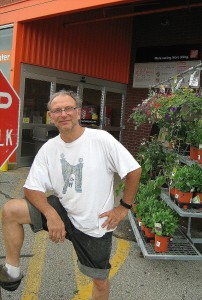
Carl Goldstein, 2011
He said, “Home Depot saved my life. Before they came to town, I used to go out to Builders Square on Wilson Mills. That was the ruination of my life. After Builders Square, I would take the freeway to DIY on Chagrin, and then to Seitz-Agin [hardware] on Lee. And I still wouldn’t have everything I needed!”
Carl worked at a plumbing supply store for seven years; he sold hot water tanks, boilers, Flushmates and plumbers dope. Carl’s father was a plumber in Flint, Michigan. Carl has a collection of Corky toilet flappers and other odds and ends in his truck. He gave me a Niagara water-saving shower head. ($5.13 from Woodhill Supply. Too specialized for Home Depot.)
I  bought more Niagaras. I have about fifty now. I switch shower heads when tenants move out. (Bad business to switch shower heads on current tenants.)
bought more Niagaras. I have about fifty now. I switch shower heads when tenants move out. (Bad business to switch shower heads on current tenants.)
Carl wants Home Depot to hold a storewide scavenger hunt. The first contestant through the Home Depot check-out line with all the correct items wins. “I’m a shoo-in,” Carl said. “Second place would be Marc Apple.”
“Marc Apple?”
“He’s a Cleveland Heights contractor,” Carl said.
There are two Jews of Home Depot in Cleveland.
—-
Read Max Apple’s The Jew of Home Depot and Other Stories. (Max Apple is not related to Marc Apple.)
Next: The Jews of Home Depot (Atlanta): Bernie Marcus and Arthur Blank.
—
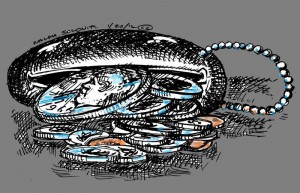 I wrote about Alice, hot weather and money at today’s CoolCleveland website.
I wrote about Alice, hot weather and money at today’s CoolCleveland website.
—
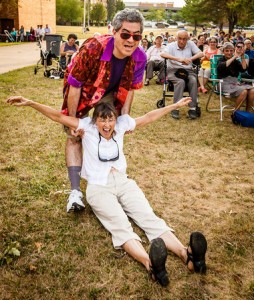 Alice and dance leader Daniel Ducoff on the front page of the Cleveland Heights Sun Press, 7/12/12. (Well-written article about Yiddishe Cup by Ed Wittenberg. Photo by Jim Olexa.)
Alice and dance leader Daniel Ducoff on the front page of the Cleveland Heights Sun Press, 7/12/12. (Well-written article about Yiddishe Cup by Ed Wittenberg. Photo by Jim Olexa.)
July 18, 2012 11 Comments
COOL CLEVELAND
My daughter, Lucy, is a corporate event planner in Chicago. She has done work for the president, Oprah, McDonald’s, Coke and Target. She has worked gigs from Turkey to Australia. Maybe I’m not allowed to say all this. (I’ll clear it with her.) She said to me, “We’re doing something [in Chicago] for Topshop. Do you know what that is, Dad? It’s a women’s fashion store from London. They want to bring in their own fashion-show coordinators from New York. They don’t trust Chicago.”

Lucy Stratton in Chi, Dec. 2007
Chicago is fourth — behind New York, Los Angeles and San Francisco — in American coolness, Lucy said. “They think we’re hicks.”
What do Londoners think of Cleveland? Do they think it’s in northern England? I think Cleveland is in northern England. [Yes, it’s a county near Scotland.]
Cleveland, Tennessee. Magic Chef makes stoves there.
Boston. That was a cool town once. In the early 1970s, young people headed to Boston. The town was popular because, for one thing, it had James Taylor . . . “[The turnpike was covered] from Stockbridge to Boston.” The Ohio Turnpike was covered from Youngstown to Toledo, but nobody noticed that.
New York wasn’t that popular in the 1970s. Chicago wasn’t either.
These days Chicago attracts young people from all over Big Ten country. Whenever I meet baby-boomers in Cleveland, I assume their kids are in Chicago unless told otherwise.
I like Pittsburgh.
“Keep Austin weird.” That’s so lame.
I would like at least one of my three adult children to move back to Cleveland. But I’m not twisting my kids’ arms. Cleveland ain’t happening, at least not like the Big Four (Chi, LA, SF and NY).
The Big Four gets old when you get old, kids.
Which city is number five? Minnie? Seattle? DC? Cleveland?
Cleveland. (I just polled myself.)
—
SIDE B
JEWS, GOD AND BAKERY
My challah purveyor is On the Rise Bakery in Cleveland Heights. I know the owner and some of the help.
I went there to put up a poster for a klezmer concert:
The cashier said, “We don’t do religious events.”
What?
I stammered, “It’s not religious. It’s the Workmen’s Circle. It’s secular. It’s bluegrass and klezmer.”
I wonder if the owner is against religion. I’ll have to ask him. I don’t think he is. He’s Jewish. I get along with him. The cashier said, “I’ll have to run it by the owner.”
I went back a week later, and the poster was up.
What if the poster hadn’t been up? I would have had to move my challah biz to another bakery — one with “religious” flyers.
Thank God, the poster was up, because I really like On the Rise.
—
For tix to the Klezmer Mountain Boys concert, click here. The concert is 7 p.m. Sunday, Mandel JCC, Cleveland.
June 20, 2012 8 Comments
THE NOSTALGIA VORTEX
About half the people I meet in Cleveland are graduates of Shaker Heights High School or Cleveland Heights High.
The others are often out-of-towners. (“Out of towner” is anybody who moved to Cleveland within the last 30 years.)
Cleveland Heights High grads like to reminisce about the Cedar-Lee neighborhood. Their nexus is the Cedar Lee Theatre and what used to be around there . . . Mawby’s, Meyer Miller shoe store, Earth by April.
One Heights guy told me he learned almost everything in life by selling shoes at Meyer Miller.
Meyer Miller’s co-owner was Cuppy Cohen.
The pool hall below the Cedar Lee Theatre was Wally’s.
Who cares? Heights people do.
Sid Abrams, the late freelance writer for the Cleveland Jewish News, wrote about Coney Island for many years. He and the Jewish News editor grew up in Coney Island. Two people in Cleveland read the Coney Island stories: Sid and the editor.
My nostalgia vortex is Mayfield Road, South Euclid. Mayfield Road was Italians and a couple Jews. My elementary school was on Mayfield, as was my high school. On my way home from elementary school, I would buy Italian bread at Alesci’s and hollow out the insides. My mother would say, “Where’s the bread?” as I handed her the crust.
West of Alesci’s was the Cream-O-Freeze; to the east, Norge Village Laundromat. It took a village . . . Jay Drugstore (for baseball cards), Lawson’s (for Hostess cupcakes), Society for Savings (for uncirculated pennies).
Excuse me, I have to check the Sohio Jackpot winners list.
June 11, 2012 No Comments
THE SCHVITZ
(A version of this appeared in The Forward online on 3/7/12, minus “Side B” — a one-minute play about The Schvitz. There is a lot of swearing in the play. You’ll like it.)
If you’re a Cleveland Jewish man and have never been to The Schvitz, you are a disgrace.
Real Cleveland Jewish men will regularly malign you, impugning your Jewish bona fides.
The Schvitz is at East 116th Street and Luke Avenue, off Kinsman Road. (In a lousy neighborhood.)
The Schvitz has no sign.
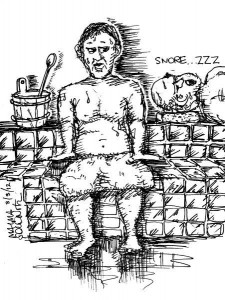 The Schvitz’s official name is the Mt. Pleasant Russian-Turkish Baths, which nobody uses. Some people call it the Bathhouse. Some people call it the Temple of the Holy Steam. (Attorney Harvey Kugelman does. Does anybody else?)
The Schvitz’s official name is the Mt. Pleasant Russian-Turkish Baths, which nobody uses. Some people call it the Bathhouse. Some people call it the Temple of the Holy Steam. (Attorney Harvey Kugelman does. Does anybody else?)
Most people call it The Schvitz. It has photos of Mussolini, Dayan and Patton on the walls. That’s it for decorations. (Plus a photo of Clint “Dirty Harry” Eastwood by the kitchen, reports Mike Madorsky.)
There are three acceptable responses to “Have you ever been to The Schvitz?”
a) I held my stag there.
b) I was there with my father.
c) My grandfather took me there.
The Big Five in Russian-Turkish–style schvitzes are in New York, Los Angeles, Detroit, Chicago and Cleveland. I got this list from Billy Buckholtz, the pleytse guy at the Cleveland schvitz. Billy’s grandfather was the original pleytse guy. (Pleytse is the rubdown, traditionally done with a broom of soaked oak leaves. Billy uses a seaweed broom and horsehair brush.)
Cleveland’s schvitz isn’t coed. Most of the other schvitzes are. The Detroit schvitz even used to have an orgy night. The Cleveland schvitz never went coed (aside from a short experiment in the 1970s) because the neighborhood is so bad. Why encourage women to come to Kinsman?
In The Schvitz’s heyday, it catered to immigrant factory workers who dropped by after work “to get the creosote off their skin, knock down a few shots and get a pleytse,” Billy said. “The immigrants didn’t want to wait in line with their eight kids for the only bathtub at their house.” Billy told me all this at a Yiddishe Cup gig at an art gallery. Not at The Schvitz.
I’m not crazy about steam.
I get periodic Schvitz invitations from the Brothers in Perspiration, an ad-hoc group of Cleveland Heights Jews. The email subject-line reads: “Have a serious jones for the stench of sweat, mildew, steak, cigar, garlic?”
That sounds good, except for the cigar, sweat, mildew and steam.
I’m due back at The Schvitz.
My bona fides. My bona fides . . .
—-
SIDE B
THE SCHVITZ (THE PLAY)
The Schvitz is a movie and a CD. Now it’s a one-minute play . . .
JIMMY, STAN AND KMETT are Cleveland cops at The Schvitz. They are in the boom-boom room (gas-passing room), lying on cots.
JIMMY, wearing only an Italian good-luck horn pendant: I used to work patrol with your son Pete in the Fifth.
STAN: That so? Where you now, Jimmy?
JIMMY: Downtown with homicide.
STAN: Pete is a meter maid in the Fourth.
JIMMY, pointing to another body: This is Walter Kmett. He’s with the detective bureau in the Third.
STAN: Did your father go to Latin?
KMETT: Collinwood.
STAN: I knew a Kmett at Latin.
KMETT: That’s my uncle.
STAN, sitting up and looking around: Is this cops-only night at The Schvitz?
JIMMY: Why? There are Jews here. A couple. I’m Jewish. They circumcise you right on the spot here. You’re next.
KMETT: They should have did Hitler.
JIMMY: Hitler was bad news.
KMETT: There are others. Ahmadinejad. Nobody says nothing.
STAN: The Israelis say “fuck you.”
BILLY THE PLEYTSE GUY walks in, waving his brush: Step right up. Twenty dollars for goys, twenty-five for Jews. I can do everything your wife can — everything for the last twenty years.
KMETT: Really, Billy? My wife and I have something magical going on.
BILLY THE PLEYTSE GUY: Such as?
KMETT: Tonight I’m making her disappear.
BILLY THE PLEYTSE GUY: What’s the admission charge?
KMETT: For you, twenty-five dollars. Where you been?
BILLY THE PLEYTSE GUY: I just got back from LA.
KMETT: Why there?
BILLY THE PLEYTSE GUY: My kids are out there.
KMETT: Nice.
BILLY THE PLEYTSE GUY: Not nice. California is one vast shithole. Everybody’s so casual there, it rubs off on the kids. What about you?
KMETT: I was down in Florida, visiting my dad. He sits on the toilet all day and reads about how to make a putt. That’s what they do down there. He got his pension — 66 percent. A shine tried to poke his eye out.
BILLY THE PLEYTSE GUY: Did you hear Ralph Friedman got 72 percent for a hangnail?
KMETT: Ralph is a scumbag. A hangnail?
JIMMY: He’s a slime bag.
KMETT: He’s the shit in the toilet.
BILLY THE PLEYTSE GUY: Ralph Friedman is my cousin.
KMETT: Your cousin? He’s still a slime bag.
STAN: Ralph is smart, I’ll grant you that. He was the Einstein of S.I.U.
KMETT: He’s a scumbag!
JIMMY: Ralphy the Alkie. He sampled more booze than Eliot Ness. Ralphy could smell booze a mile away.
STAN: He’s a goose.
BILLY THE PLEYSTE GUY: He’s not my cousin.
JIMMY: You schmuck, why’d you say he was your cousin? Where are the steaks?
KMETT: It smells in here.
BILLY THE PLEYSTE GUY: That’s garlic.
KMETT: That’s not garlic. This place is one vast shithole.
—
Ralph Solonitz’s illustrations, above, were in The Forward print edition, 3/16/12, and online, 3/7/12.
—–
Re: Kickstarter
I’m dubious of over-40-year-olds asking for money on Kickstarter.
My friend Mike got hit up by an old guy/ friend who was trying to raise $100,000 for a sculpture project. Mike said to me, “Let him get a job. What am I — his relative?”
Under 40, you can play Kickstarter.
Synth-player Jack Stratton and banjoist Rob Stenson are trying to raise $2,400 on Kickstarter. The young duo has 10 days left to reach its goal. They are more than halfway there, with $1243 and 70 backers.
Kickstarter chose the Stenson-Stratton project as a pick-of-the-week. The project video (below) features Jack as a German. Kickstarter co-founder Yancey Strickler wrote, “These guys make the best/weirdest projects.” (Helps if you’re under 40 — like Strickler and his Kickstarter crew — to fully appreciate the vid and work.)
Watch the video, then click here to donate.
May 23, 2012 8 Comments
THE SILVER FOX / THE CREEP
Charlie Broeckel was the Silver Fox or The Creep. He went by both names. He was a burglar and hit-man in Collinwood –- a neighborhood in northeast Cleveland.
I’m not sure where Broeckel is now. Maybe he’s dead. Or maybe he’s in a safe house in Ada, Oklahoma. For a while he was “John Bradford” (federally protected) in the Pacific Northwest.
Broeckel and Phil Christopher — another Collinwood burglar — did a bank heist at Laguna Niguel, California, in 1972. It was supposedly the biggest bank burglary of all time. Charlie and Phil flew to California from Cleveland for the job. California didn’t have quality bank burglars back then, I guess. Collinwood did.
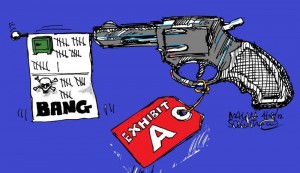 I saw Broeckel and Christopher at trials in Cleveland. They would periodically come in from their federal prison cells or witness protection program locations. One trial was for murder: Christopher and accomplices took a pimp, Arnie Prunella, out on a boat, shot him and drown him.
I saw Broeckel and Christopher at trials in Cleveland. They would periodically come in from their federal prison cells or witness protection program locations. One trial was for murder: Christopher and accomplices took a pimp, Arnie Prunella, out on a boat, shot him and drown him.
Collinwood was “think ethnic”-to-the-10th power. There were four distinct neighborhoods in Collinwood: Slovenian (St. Mary’s parish), Italian (Holy Redeemer), black (west of the E. 152nd Street, aka the DMZ) and Lithuanian (Our Lady of Perpetual Help). Broeckel’s ethnicity was indeterminate. Maybe German, maybe Slovenian. Christopher was Italian.
Broeckel and his fellow burglars stored nitroglycerin — used for blowing up safes — on a Lake Erie beach. In 1983 a Cleveland policeman operated a backhoe at the local beach, searching for old, very unstable nitro. Traffic cops kept reporters and passersby at a distance. Charlie was supposedly in bad health and wanted brownie points for helping the cops find old explosives.
The chief cop in the neighborhood — Capt. Ed Kovacic — had a warm spot for highly skilled crooks. These thieves would drill out safes and jump burglar alarms. They weren’t entirely stupid. Kovacic often said, “If there was a hall of fame for burglars and safecrackers, it would be in Collinwood.”
In 2006, Lyndhurst police chief Rick Porrello wrote a book, Superthief, about Christopher. Then Tommy Reid, a Hollywood entrepreneur, made a documentary movie –- also Superthief — which came out in March. The movie is mostly talking heads: old cops and old thieves sitting in living rooms, reminiscing about old days.
The documentary ran exclusively in theaters in Euclid and Lake County — where many former Collinwood residents moved to. There were three people in the Lakeshore Cinema. One elderly man, with a walker, said on his way out, “Phil is a thief!” His wife said, “I like Phil!”
Christopher, 66, is out of jail. He has spent nearly half his life in prison. What if Broeckel — the creep, the silver fox, the rat — comes out of hiding and puts Christopher back in prison?
Just like old times.
—
I was a police reporter in Collinwood for Sun Newspapers in the 1980s. (Last time I’m going to mention this factoid for a while. So please remember.)
—-
SIDE B
Here is the annual “inside baseball” post. Your name might be in here . . .
NAMING NAMES
We interrupt this blog to tell you this blog is three years old.
“I’ve read every word of your blog!” a musician told me.
Hooray for him. I wrote every word.
A blog reader said, “You found your subject — your father, Toby.”
No, you did. I’ve had Toby on the brain for decades.
A woman said, “I look forward to your posts every Wednesday morning . . . I don’t do comments.”
Here’s my comment: Nine-tenths of Klezmer Guy readers don’t do comments. They want to protect their animosity. Listen, you are not above comments; you are not paying for this; chip in the occasional enlightening, humorous or really stupid comment.
Several other readers claim to have read every word of the blog.
What was the first word?
Special thanks to our major donors (commenters). I could have done it without you, but it wouldn’t have been as much fun.
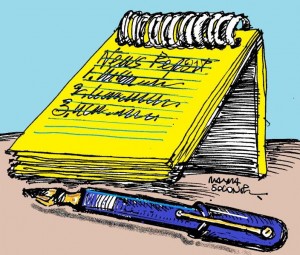 In no particular order, thanks to Marc Adler, Jessica Schreiber, Gerald Ross, Seth Marks, Ted, Adrianne Greenbaum, Bill Jones, Mark Schilling, Harvey Kugelman, Ellen, Susan Greene . . .
In no particular order, thanks to Marc Adler, Jessica Schreiber, Gerald Ross, Seth Marks, Ted, Adrianne Greenbaum, Bill Jones, Mark Schilling, Harvey Kugelman, Ellen, Susan Greene . . .
David, Margie, Irwin Weinberger, Jane Lassar, Zach Kurtz, Alice Stratton, Alan Douglass, Steve, Jack, Don Friedman, Kenny G, Steven Greenman . . .
Charlie B, Don Edwards, Garry Kanter, Jack V, Ari Davidow, Emilie, B Katz and Richard Grayson.
Get your name on this list next year by contributing at least $2,500 or writing comments.
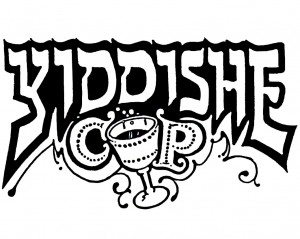 Special thanks to Ralph Solonitz, the blog’s illustrator. He adds a lot. I encourage him to throw in as many pics as possible. Works out well. Ralph had a Klezmer Guy illustration in The Forward recently.
Special thanks to Ralph Solonitz, the blog’s illustrator. He adds a lot. I encourage him to throw in as many pics as possible. Works out well. Ralph had a Klezmer Guy illustration in The Forward recently.
I met Ralph about 21 years ago when he designed Yiddishe Cup’s logo. That’s still your best logo, Ralph.
Sometimes I send my stories to the media before posting here. This past year Klezmer Guy articles were published throughout the planet: the International Herald Tribune, New York Times, City Journal, Ann Arbor Observer, Cleveland Plain Dealer, Jerusalem Post. Did I miss any continent? I’ve started to link to some of the newspaper articles. Please see the right side of this blog, under “Articles.” Also, check out “Categories” there. “Categories” is particularly useful if you want to read 68 posts in a row about real estate.
Google Analytics — a spy op — says there are Klezmer Guy readers in every state and many foreign countries. Ohio has the most Klezmer Guy readers, followed by New York, California, Michigan and Massachusetts. The top foreign countries are Canada, United Kingdom, Israel, Germany and Australia.
Google Analytics, for your information, zeroes in on readers by their hometowns, not their names. For instance, somebody in Chico, California, reads this blog.
The bell rings, round four.
—-
I wrote this op-ed, “The Impossible Dream,” for Mother’s Day for the Cleveland Plain Dealer (5/13/12). It’s about listening to the radio with my mother.
Illustration by Ted Crow, Plain Dealer
May 16, 2012 10 Comments
CHIVES AND WWII
The title of Maury Feren’s autobiography is almost book-length: Wheeling & Dealing In My World, Including World War II Memories, by Maury Feren, Cleveland, Ohio’s Produce King.
Lettuce and tomatoes aren’t that compelling to me, but World War II is, so I read the book.
Maury fought the war on two fronts: 1.) Europe and 2.) Europe — against his fellow American soldiers.
Here are some chapter titles: “Another Bigot,” “I’ll Show You What a Dirty Jew Can Do,” “Anti-Semitism at Home and Abroad” and “More Anti-Semitism.”
An American soldier called Maury a “rag peddler.” Maury “gave him a lesson in boxing that he might never forget.”
A mess hall server said to Maury, “Vot vould you lick? A piss of this, and a piss of that?”
Maury grabbed him by the throat. “If you ever talk like that again to me, I’ll close your windpipe so you’ll never be able to talk again.”
Maury encountered German soldiers and civilians in Essen, Germany. “I screamed at them in a Yiddish-kind-of-German about how despicable they were . . . ‘You are murders, baby killers, women killers . . . I am a Jew. Look at me and see whether you want to kill me too.’”
Maybe I’ll read Maury’s chapter on chives.
Probably not. Is there any ass-kicking in chives?
—-
Footnote: Maury, 96, is still kickin’. Biz a hundert un tsvantsik, Maury. (You should live to 120, Maury.)
—-
Jack Stratton, Yiddishe Cup’s alternate drummer, as Mushy Krongold:
December 7, 2011 3 Comments
COPS ARE FUNNY
Cleveland cop Tommy Alusheff moonlighted as a comedian, using the stage name Morey Cohen — a conflation of Morey Amsterdam and Myron Cohen (two of Alusheff’s favorite comedians). Morey Cohen worked at Hilarities and other regional comedy clubs, plus he did some out-of-town gigs, like in Los Angeles.
Morey Cohen’s father, Chris Alusheff, owned the Baker Candy factory in Collinwood. Chris Alusheff once told me Jews like dark chocolate more than gentiles like it. Why? Kashrut? (Kosher dietary laws?) Probably. The Alusheffs were Macedonians. Their best-selling product was chocolate-covered whipped candy eggs, sold at Easter time.
Morey Cohen died last year. I didn’t go to the funeral; I only knew him by reputation. Morey wasn’t in the Sixth District, which had been my police beat. (I was a reporter in the 1980s.)
The top comedy cop at the Sixth District had been Paul Falzone, a stand-up guy, but not a stand-up comedian. Falzone was almost ready for prime time. I hung out with Falzone in the burglary unit at the East 152nd Street station, aka The District, the cop shop. The building had few windows. It was a fortress, built after the 1967 Hough riots. When the A/C went out in the building, it was a real sweat shop. Falzone said, “I have eight minutes of material to Morey’s twelve.”
Falzone asked me, “How are the Jewish holidays treating you?” It was September.
“Fine.”
“You’ve got to watch for neo-Nazis,” he said.
“Why?”
“Everyone has to watch for somebody. Italians, they got to watch out for other Italians; you start your car and it goes ba-boom instead of vroom. The Irish, they got to watch for Jack Daniels. Hey, how can you tell Ronald McDonald at a nudist colony?”
“How?”
“He’s the one with sesame seed buns.”
Falzone ran for county sheriff, and president of the patrolmen’s union. He didn’t win either. He eventually became police chief of Bratenahl, a suburb. Now he’s running for mayor of Bratenahl.
Two years ago Cuyahoga County tried to put Falzone in jail for theft. Something about drugs and guns missing from the Bratenahl property room.
Falzone was acquitted. Now he’s suing Bratenahl for “humiliation.” Doesn’t sound funny, but Falzone can probably get some jokes out of it. Bad jokes. He needs only four more minutes to match Morey Cohen . . .
“So I’m on patrol, and I walk into the Viking bar. I see a 16-year-old punk with a Miller’s. I say, “When’s your birthday, kid?”
He says, “October 10.”
“What year?”
“Every year.”
—
Footnote: The Sixth District became the Fifth District in 2008, when the Cleveland Police Department reapportioned the districts.
—
From illustrator Ralph Solonitz’s Parade of Nations collection:
September 28, 2011 5 Comments
HOLLYWOOD BOWLS US
My wife, Alice, was one of the many star-struck fans who drove to Rockside Road and I-77 in Cleveland to audition for The Avengers movie.
I asked Alice, “Did you get the part? Did you read anything?”
Not only did she not read, she did not even audition. The traffic was so horrendous at Rockside Road, she turned around. Thousands of people had shown up for the audition. The line of wannabes snaked at least a mile from the building, according to the Cleveland Plain Dealer.
There was another Hollywood movie, Fun Size, filmed a few weeks earlier, several blocks from our house in Cleveland Heights. That’s when Alice got star struck. Catering and make-up trucks were around our neighborhood.
I heard about it. I didn’t want to see the trucks. I have a bias against Hollywood.
Hollywood guys have too much fun. They should be making radiator valves, or PVC pipe fittings, like the rest of the world. Not blowing things up and eating from catering trucks.
My wife’s school gym (where she teaches elementary-school physical education) was turned into a vast make-up room for Fun Size. She said the school board got $500,000 for the rental.
I didn’t believe that. Alice’s source — the school janitor — told her the five-hundred grand figure.
Make that $50,000. I’d accept that. Better yet, $5,000. Who would pay half a million to rent a school building for a couple days? Hollywood is a funny ballpark, but not that funny.
Hollywood’s latest tax-abatement haven/heaven is Ohio. Used to be Michigan.
I would like to be in a movie, Alice. But I would demand some lines and star food. No way am I going to be a man in the crowd, not at this point in my career.
I want to blow up something. Grab a lighter, Alice. You have a role.
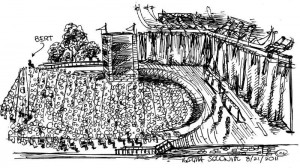
Those Lips, Those Eyes, United Artists, 1980, Cain Park amphitheater, Cleveland Heights. Bert Stratton at far left.
—-
A version of this story is crossposted today at CoolCleveland.com.
August 31, 2011 4 Comments
HE MADE A LIVING AT MUSIC
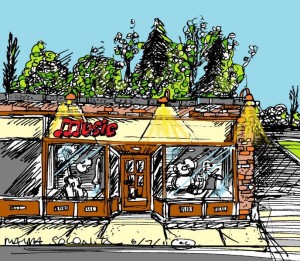
Barry Weinberg, the owner of Mayfield Music in Cleveland Heights, rented PA systems and sold amps, guitars and drums. He died at 55. He was a rocker who lived hard. The sign at the back of his store read Give Me the Dough and You Can Go.
He carried a quality line of blues harps.
Before Barry, Mayfield Music was Chick Chaikin’s store. Chick lived pretty hard too, but in a middle-class way: Chick golfed, raised a family and played thousands of cocktail-piano gigs.
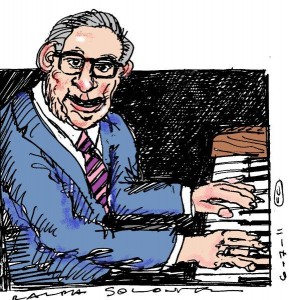
Chick Chaikin
Chick was a big-band leader and solo pianist for decades. He played six nights a week at the Colony Restaurant, and knew just about every pop song written, according to trumpeter Bob Dreifort, who I talked to recently.
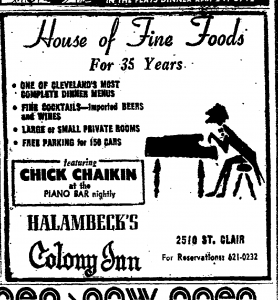
Cleveland Plain Dealer, 8/23/74
Chick’s brother Bill went out to Hollywood and eventually ran a movie studio, Avco Embassy. Bill was involved in The Graduate and more.
“I could have gone to the Coast too,” Chick said. “But my life is here, and I have my work, although every winter I say this is it. But I’m still here.” (Plain Dealer interview, 1977)
Chick’s store was Currier-Chaikin Music. Chick’s business partner, John Currier, was even older than Chick. John Currier had played piano at Euclid Beach Park in the 1920s.
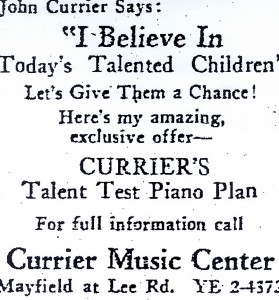
Cleveland Plain Dealer 1/23/53
Chick called me “Toby’s son.” Chick didn’t know my name. Chick and my father, Toby, were Kinsman Road boys.
Most of my father’s friends and acquaintances were businessmen: shoe store owners, insurance men, pawn shop owners.
How did my dad know a full-time musician? I guess Toby had no choice. Toby and Chick grew up almost next door to each other.
How did Chick wind up a full-time musician? I didn’t ask old people questions like that when I was in my twenties.
Chick’s life was all about family and music, his daughter, Jeri, told me this year. For a while Chick had a side job giving private music lessons through Cleveland public schools.I didn’t have the chutzpah to ask Jeri if there was more to Chick’s headstone than Leonard ‘Chick’ Chaikin 1915-2000.
Here are three fitting epitaphs:
a) “Here lies a man who made a living at music.”
b) “Chick a la King.”
c) “I’m here 7 nights a week.”
July 6, 2011 10 Comments
OLD JEWISH MONEY
AT DRUG MART
Drug Mart is a dollar store/drugstore on Cleveland’s West Side. I buy shampoo and cough drops there. Also, shoehorns, Gorilla tape and off-brand Cheerios (formerly Tasteeos, now Toasted Oats).
Drug Mart sells the Wall Street Journal and the New York Times, but I never see anybody buy the papers except for an elderly man in a suit and tie.
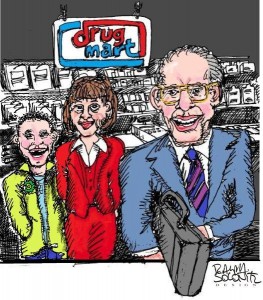
What is this guy doing on the West Side?
I stood in back of him in line, and had time to kill. I said, “I wouldn’t normally bring this up — like if we were on the East Side [where the Yidn live] — but you look like my uncle. You have to be a landsman.” [Paisan]
He smiled and said, “I’m Charlie Lichtman. And what are you doing here?”
“I own property here.”
“Houses?”
“Buildings, like the old Armed Forces Recruiters building.” Which was two blocks away.
Charlie said, “I live in the new Armed Forces building.” The fancy condos — with recruiting offices underneath — across the street from my building.
“You aren’t from around here?” I said.
“I’m from New York,” he said, handing me a card: Charles M. Lichtman Jr., attorney at law, Cleveland and
New York.
“I had an article in the New York Times yesterday,” I said. I was just waiting for somebody — anybody — to say “New York,” or “times” or “new.”
“I read the article,” Charlie said.
I Googled Charlie when I got home. He had graduated from Harvard University and Harvard Law School, and so had his father (Harvard ’14, Harvard Law ’16). His father had been the president of the Harvard Menorah Society (a precursor to Hillel) in 1915.
Charlie was apparently old German Jewish money (“Our Crowd” division, NYC). And he was at the Drug Mart on the West Side of Cleveland.
Why?
An attractive woman stood next to him. “That’s why I’m here,” Charlie said, pointing to her.
—
“Charles M. Lichtman Jr.” is a pseudonym.
—
Enjoy the “Klezmer Guy” blog, with w/ beer, food
and music . . .
Nighttown
Tues. June 14
7:30 p.m.
$10
Spoken word, klezmer, rock, pop, Tin Pan Alley and alley.
Bert Stratton, clarinet, spoken word
Alan Douglass, piano, vocals
Jack Stratton, drums, beat-box
Lots of new material in this show. Your name might pop up in the script.
Nighttown
12387 Cedar Rd., Cleveland Hts.
216-795-0550
www.nighttowncleveland.com
—
Yiddishe Cup — the whole band — is at Parade The Circle, Cleveland, 11 a.m. Sat., June 11. We’re playing a pre-parade concert.
We’ll also be at Temple Israel (Akron, Ohio) that night (June 11), 8 p.m., for a concert. 330-762-8617.
June 1, 2011 4 Comments
THE ESTHER ISENSTADT ORCHESTRAS
Bass player Esther Isenstadt ran classified ads in the back of the Cleveland Jewish News in the 1970s and 1980s: “Sophisticated music for discriminating people” . . . “Leave your records at home and bring LIFE to your party” . . . “From ‘The Hora’ to ‘Beat It.'”
Esther was gigging regularly when Yiddishe Cup started in 1988. I didn’t run into her. She was working the senior-adult circuit, while Yiddishe Cup was doing the glam jobs: bar mitzvahs and weddings. Esther was not a klezmer musician. She played mostly classical and pop — and some Jewish.
When I eventually met Esther, she was in The Weils assisted living facility. She was 86 (2003). She approached me after a Yiddishe Cup senior-adult program to say hello. I told her I knew of her. She smiled. I had one of her songbooks; I said I bought it used at the Cleveland Music School Settlement. She smiled again. Then she didn’t smile. She said, “I never thought I’d end up here!”
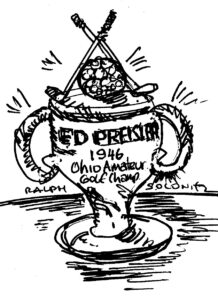 Ed Preisler — another Weils resident — chimed in, “I came out here to die.” (Ed died six months later.) Ed was the 1946 Ohio Amateur Golf Champion.
Ed Preisler — another Weils resident — chimed in, “I came out here to die.” (Ed died six months later.) Ed was the 1946 Ohio Amateur Golf Champion.
Ted Bonda, the former owner of the Cleveland Indians, was also there. I switched gears; I asked Ted, Ed and Esther — and the other people schmoozing after the program — if they knew Mickey Katz. One resident knew Mickey from Yale Avenue, Cleveland; another, from Berkshire Road, Cleveland Heights.
I asked the group if they were familiar with the word kile (hernia). Nobody knew it. That was surprising. Kile is the punch line in Mickey Katz’s song “16 Tons [of Hard Salami]” . . . “The balebus (boss) promised me a real gedile (glory), instead of geldile I catched me a kile (hernia).” The Weils was apparently not heavy-duty Yiddishists.
Esther Isendstadt had played in four suburban orchestras, raised a family, taught elementary school, led party bands and taught ESL in “retirement.” She was a Glenville High graduate, as were Bonda and Preisler. Glenville High was where Jewish overachievers went to high school in the 1930s. [John Adams High students — like my parents — would have disagreed with that. John Adams, in the Kinsman neighborhood, was more proste (working-class) than Glenville, but equally proud.]
I learned “Shir Lashalom” (A Song of Peace) from Esther’s book. That tune was a must-play in 1995 — the year Yitzhak Rabin was assassinated. The lyrics were in Rabin’s pocket when he got shot.
Esther had rubber-stamped Esther Isenstadt Orchestras on every other page of the used song book. A Jewish bandleader with a rubber stamp.
I got a rubber stamp.
Esther died last month at 93.
There weren’t many bands with names like the Esther Isenstadt Orchestra in the 1970s. There still aren’t.
—-
Illustration by Ralph Solonitz.
November 19, 2010 5 Comments
SHOUSE
If you’re on the Cleveland Workmen’s Circle concert committee, there’s a 25 percent chance you’ll be dead in 10 years. (I counted the dead from a 10-year-old committee roster.)
An elderly woman suggested we include a tribute to a recently deceased committee member in our concert brochure. But the brochure’s cover already read “in memory of Eugenia and Henry Green,” the concert’s principal funders.
I said, “People are dying on this committee every other year. We can’t be putting in written testimonials.”
“Like who? Who’s dying?” the woman asked.
I didn’t name names. Why sidetrack the meeting?
The committee met in a room under a portrait of Eugene V. Debs. A photo of Norman Thomas was in the hallway.
This committee in its prime — about 20 years ago — was like hanging around the cafeteria at CCNY or Western Reserve University in the day. There had been Max Wohl, Socialist (capital S) and major ACLU donor; David Guralnik, editor of the New World Dictionary; Herman Hellerstein, the cardiologist who first recommended, in the 1960s, exercise after heart attacks; and Harold Ticktin, Mississippi civil rights lawyer (summer 1965), authority on the Jewish Bund, and former “Kinsman cowboy” (Kinsman Road loiterer). Ticktin said the Jewish Kinsman cowboys in the 1930s called the Italian Kinsman cowboys “noodles” and shkutzim (gentile boys).
Committee members occasionally called each other “friend,” a quasi-socialist salutation.
Several “friends” decided to honor Yiddishe Cup with a Workmen’s Circle dinner. What Yiddishe Cup didn’t know: the honoree paid to be honored.
Ben Shouse, friend in charge of fundraising, had a booming voice and a shock of gray hair like H.L. Mencken. And he wore suits like Mencken, and he smoked a cigar like Mencken. Politically, Shouse was un-Menckenable. Shouse was a retired labor union boss, autodidact (he liked inculcate), and an advocate for the arts, especially “Shakespeare for the workers”-type events.
Shouse phoned me, suggesting Yiddishe Cup musicians pony up for the banquet. He said, “Stratton, you know how these things work. Cooperate!”
I didn’t know how these things worked. Not in 1994, I didn’t. I thought Yiddishe Cup was being honored because we were good — some sort of arts prize. I had played tribute dinners before, but had never understood the dynamics. Shouse said he had raised thousands at a previous dinner in honor of his elderly girlfriend.
Two Yiddishe Cup musicians told me they couldn’t afford the price of the dinner, let alone bring friends, or crazier yet, “buy a table.”
I corralled three people, including my wife, to attend. I hesitated to hock friends, particularly for a chicken dinner at a windowless Alpha Drive party center. And my friends would have to listen to speeches about a fraternal organization, Workmen’s Circle, most had never heard of.
Shouse phoned Yiddishe Cup’s singer and said to him: “Stratton gave fifty-five dollars. Greenman gave twenty-five dollars. How about you? And who are you bringing?”
Shouse nearly traumatized my singer, a sensitive artist.
One Yiddishe Cup musician didn’t bother to show up for the tribute. Another musician rewound his Shouse phone message for me: “This dinner is in your fucking honor! You’re sophisticated. You know the rules. Do your part!”
Shouse died in 2003. He raised a lot of money for the arts in Cleveland.
—
Coda:
This year the concert committee added several younger members. Odds are now probably less than 25 percent of a random-selected committee member dying in the next 10 years. Also, the Eugene V. Debs and Norman Thomas pictures are down. Rebbe Menachem Schneerson is up. A Chabad-affiliate organization bought the Workmen’s Circle building and shares it with the Workmen’s Circle. Now playing in Cleveland: Enemies: A Love Story.
May 26, 2010 6 Comments
FOR WHOM THE T-BELL TOLLS
While waiting in line at Taco Bell, I tried to unlock the mystery of the restaurant’s warning: “Time Delay/Time-Lock” safe can not be opened for 10 minutes and up to 18 hours.
I couldn’t unlock it.
The other drawback — and a big one — to my West Side T-Bell hangout was the manager locked the restrooms because of vandalism. I had to ask for a key. The manager lost some of my business because of that. Please, can I go? I didn’t like repeating first grade.
I was at Taco Bell when the founder, Glen Bell Jr., died. I hadn’t known a Mr. Bell existed until I read his obit. A customer broke the news to me — not about Bell’s death — but about the manager not locking the restroom door anymore. In memory of Glen Bell Jr.? In the obit, Bell said customer service was paramount.
Hallelujah for the new open door policy, Brother Bell.
The customer in front of me said, “They finally got smart here. People come in here after hours on the road, and they have to go!”
I frequented T-Bell more often because of the new restroom policy. And I developed a new T-Bell hang-up — a musical one. I asked the young cashier to name the horrible song playing. She couldn’t. Name the artist? “It’s satellite,” she said.
Put cilantro on that satellite radio station, hon. Quash the piped-in Lady Gaga music. The customer comes first.
—
2 of 2 posts for 4/21/10
April 21, 2010 4 Comments
GORDONS PARKED
When I was growing up, saying “Jewish music” was like “Jewish cars.” Didn’t mean a thing.
On second thought, “Jewish cars” did mean something. It meant, for example, the Boat — an Olds 98 owned by my friend Mark’s father. The Boat had electric windows and was oceanic. (Mark was richer than the rest of us, I think. He lived by Cedar and Green roads, and his doorbell lit up.)
Years later, a West Side gentile called those humongous Detroit rides “Jew boats.” So maybe there were Jewish cars.
Re: Jewish music . . .
I learned about that at the house of another high school friend, Shelly Gordon. His parents knew Israeli and Yiddish music, cold. Shelly was rarely home. I was an adult when I got interested in Jewish music, and Shelly had already moved to Israel. (His parents were such impassioned Zionists most of the family wound up in Israel.)
Shelly’s parents were Labor Zionists (Poale Zion). They seemed to know every classic Israeli tune and how to dance and/or sing it. And the Gordon family attended a Yiddish camp in Michigan. (Farband/Jewish National Workers Alliance.)
The parents didn’t know sports, which was odd because Shelly turned into a star athlete. He played tennis for Ohio State and became a tennis pro in Israel. Shelly did that for more than 30 years. (Still at it.) He never took a private tennis lesson.
Shelly didn’t care about Jewish music; he cared about the Browns, Buckeyes and Indians. In Israel he logs on — to this day — at about 3 a.m. to catch Cleveland sports scores on the Internet. He has a yarmulke that reads “Cleveland Cavaliers.”
When I went to Jerusalem in 2006, I played The Wall. Shelly. At the Israel Tennis Center, Shelly was like Moshiach (Messiah); he had the highest seniority and everybody deferred to him. He had even beaten Andy Ram, a Wimbledon doubles champion. “Andy was 12 at the time,” Shelly pointed out.
Shelly’s dad, Sanford (the man who knew all the Hebrew tunes), never played tennis. In fact Mr. Gordon was so oblivious to sports he didn’t even sign Shelly up for Little League. Mr. Gordon was not an immigrant or DP (Displaced Person); he was a NASA scientist and full-time Zionist. Baseball meant nothing to Israelis, thus, it meant nothing to Mr. Gordon.
Shelly went to a Zionist camp in Michigan. (Habonim Camp/The Builders.)
On the flipside: My parents played tennis; didn’t collect Jewish song books; didn’t send me to any kind of camp; and my dad managed a Little League team. So I wound up playing klezmer music.
When Mrs. Gordon died last month, her body was flown from Israel to Cleveland, to Mt. Olive Cemetery. A twist on shipping an American Jewish corpse to Mt. Olive, Jerusalem. Mrs. Gordon wanted to be buried next to her late husband.
At Mrs. Gordon’s funeral, I had time to kill because the mourners, following Orthodox tradition, shoveled mounds and mounds of dirt into the grave. Took a half hour. I noticed Mr. Gordon’s tombstone said on the back side: “A kind and gentle man loved by all.” In his case, true.
Mr. Gordon was eydl (polite/refined). Also, a rocket scientist and excellent balloon twister. His wife, Beatrice, had gone to college and social work school after raising children. She wasn’t idle.
When my kids were little, I took them to the Gordons often. (The Gordon grandchildren were in Israel. That worked out well for my family.) I called Mr. and Mrs. Gordon “Beasan” behind their backs. It was a contraction of Beatrice and Sanford, as in: “Let’s go to Beasan’s for pizza and some magic tricks.”
What a pair.
—-
1 of 2 posts for 11/11/09. Please see the post below too.
November 11, 2009 2 Comments
FISHY
1. JEWISH FORK-LORE
Musician Mickey Katz called chocolate phosphates “Jew beers.” He drank them at Solomon’s on E. 105th Street.
I drank mine at Solomon’s at the Cedar Center shopping strip, where Solomon’s moved to.
For some Semitic semantic reason, goys occasionally called Cedar Center the Gaza Strip. Now it kind of is. The north side of Cedar Center is concrete chunks and gravel heaps. A real estate developer knocked down the 1950s-era plaza and plans to redevelop. Who knows when.
Solomon’s was my family’s deli of choice. My father, Toby, was a “deli Jew.” In the Jewish world, that’s usually a putdown, meaning the person knows more about corned beef than Rashi. Toby’s favorite food was a “good piece of rye bread.”
Toby, a phosphate fan, probably didn’t drink more than a dozen real beers his whole life. He should have. In his retirement, when he drank booze he smiled a lot more. A bit shiker at one party, Toby teed off on a watermelon fruit bowl with a golf club. That stuck with me. [Shiker is drunk.]
Toby grew up in a deli. His mother had a candy store/ deli at E. 118 Street and Kinsman Road. She sold it to her half-brother when he came over from the Old Country. Something fishy about that deal — something involving the half-brother’s wife. My grandmother went from candy store/deli owner to simply candy store owner. Not a lateral move.
At the Gaza Strip, there was also Corky & Lenny’s. (Still around — four miles east.) A couple small Jews hung out in the rear booth at Corky’s. One was Harvey, who did collections for a major landlord. (Major, to me, means more than 1,000 units.) I knew Harvey from junior high.
He sued my mother. My mother, for health reasons, moved from her Beachwood apartment after 27 years into an assisted living facility. She had a couple months left on her lease. Harvey, who represented the major landlord, went after her. Harvey’s boss, by the way, loved my band. So what. My mother was collectable.
Freelance journalist David Sax just wrotea book about the decline of delis. Here’s something for the second edition, David: Delis went downhill when they added TVs. Now you have to watch the Browns while you eat.
I was deli-famous. At Jack’s Delion Green Road, I had a thank-you note up in the entrance. My letter was about the terrific tray for my firstborn’s bris. Fatherhood was about buying huge quantities of smoked fish. What a blast. (I ordered the exact same tray for my daughter’s naming.)
I complimented Jack’s Deli on its fish, which my Aunt Bernice, The Maven, also liked. I mentioned “The Maven’s seal of approval” in my letter. Bernice work for a food broker and knew food.
My letter was up for a couple years.
—
(Acknowledgment to Henry Sapoznik for “fork-lore” in this story’s title.)
***
2. ’DINES
The trend at mass-feed kiddushes (post-service temple chows) is toward Israeli foods: hummus, baba ganoush, Israeli salad.
When you privatize — and don’t invite the whole congregation — you typically add some fish.
All Jews like a good piece of fish: lox, smoked fish, herring, the occasional sardine.
My youngest son recently called from Trader Joe’s in Ann Arbor, Mich., and said, “Don’t get excited, Dad, but do I want the sardines in oil or water?”
“Oil.”
I did get excited. My college kid was finally getting into ’dines.
My mother had given me about eight cans of ’dines when I went off to college. I ate them on Sunday evenings, when the dorm cafeteria was closed. (This was back when sardine cans opened with a key, and the ’dines were Portuguese — not Moroccan like now.) Surprisingly – to me at least – the guys in the dorm wouldn’t share my ’dines. Pizza time.
I liked all kinds of ’dines. Even the monster-size sardines in tomato sauce were OK. Bones, no bones . . . no matter. Cajun sauce, soya oil, olive oil, mustard sauce . . . all good. Four ’dines in a can, two in a can . . . either way.
Anchovies? Also, an excellent choice. Make sure you buy your anchovies in a bottle; they last longer than in cans.
Herring in wine sauce. Beware. Last month Heinen’s supermarket substituted Vita brand for Golden Herring. That was lamentable. Vita is too sugary.
At luncheons, the other Yiddishe Cup musicians don’t seem to appreciate the fish (i.e., the “dairy spread” in kosher parlance) as much as I do. Yes, they like the lox. Lox is apple pie. But the other items (smoked fish excluded) get little play from the band. You should see the mountains of herring left over.
October 21, 2009 17 Comments
